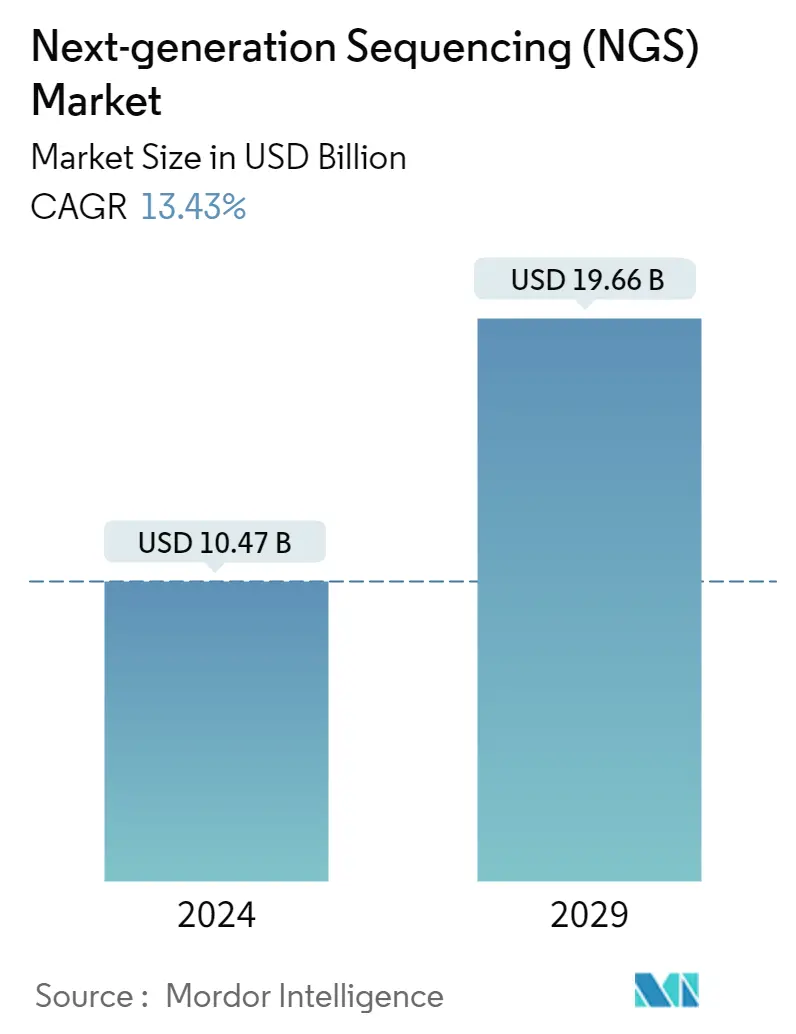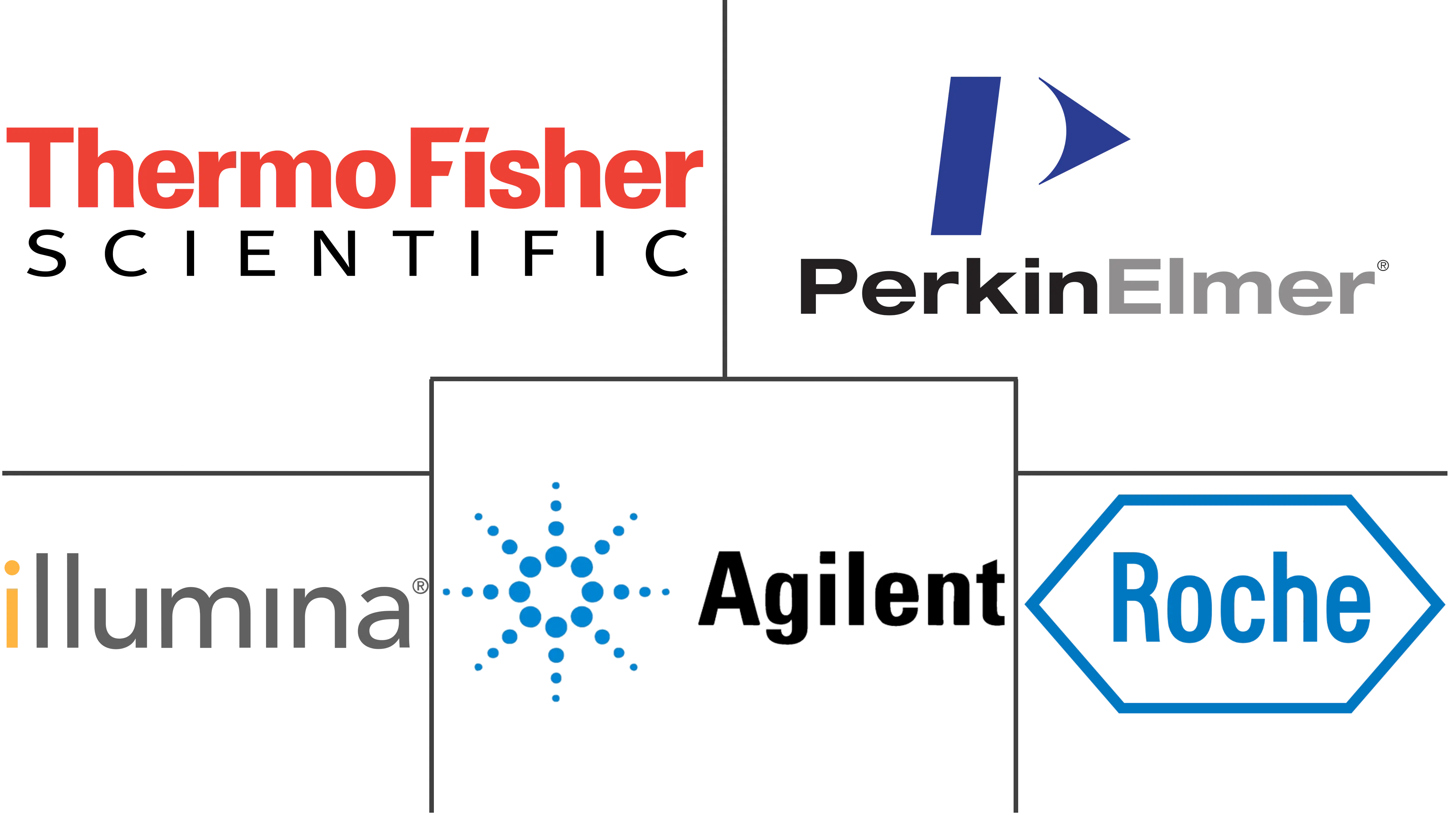Market Size of Next-generation Sequencing (NGS) Industry

| Study Period | 2019 - 2029 |
| Market Size (2024) | USD 10.47 Billion |
| Market Size (2029) | USD 19.66 Billion |
| CAGR (2024 - 2029) | 13.43 % |
| Fastest Growing Market | Asia-Pacific |
| Largest Market | North America |
Major Players
*Disclaimer: Major Players sorted in no particular order |
Next Generation Sequencing (NGS) Market Analysis
The Next-generation Sequencing Market size is estimated at USD 10.47 billion in 2024, and is expected to reach USD 19.66 billion by 2029, growing at a CAGR of 13.43% during the forecast period (2024-2029).
The NGS diagnostic technology was able to find out a virus's genetic sequence and helped scientists figure out how mutations happen. During the COVID-19 pandemic, governments all over the world worked with the private sector to try to get NGS technology on the market as a possible diagnostic tool.For example, an article published by Frontiers in March 2022 says that next-generation sequencing (NGS) was used to study COVID-19, which made it much easier to find out where SARS-CoV-2 came from.It also said that NGS was important for looking into the possible origins and workings of SARS-CoV-2 in order to stop the spread of COVID-19 and make the treatment plan even better.Thus, the use of NGS technology increased throughout the pandemic phase. However, post-pandemic, the NGS market is expected to have stable growth during the forecast period of the study.
Factors such as the increasing applications in clinical diagnosis and speed, cost, and accuracy, and the increasing efficiency when compared to traditional technologies such as microarrays and the rising number of drug discovery applications are expected to boost market growth.
An upsurge in the use of NGS technology in clinical diagnosis and the speed, cost, and accuracy of this sequencing method are likely to boost the growth of the market. For instance, NGS has a lot of advantages over conventional sequencing techniques, according to an article from PubMed Central published in January 2021.These advantages include a higher throughput with sample multiplexing, a higher sensitivity for finding low-frequency variants, a faster turnaround time for high sample volumes, and a lower cost.Additionally, a PubMed Central article from April 2021 claimed that because NGS is capable of massively parallel sequencing and is steadily replacing its predecessor, conventional Sanger sequencing, it has significantly influenced the demand for more affordable and quick sequencing technologies.It is expected that NGS's advantages will help the market grow over the next few years.
The market is also expected to grow because replacing old technologies like microarrays will make them more efficient and because more drug discovery applications will need NGS technology.For example, an article published by Elsevier in August 2022 said that NGS was better than microarrays at detecting DNA and doing other genomic tasks.
Additionally, several market players are playing a key role in the development of drugs through this technology, which is also expected to boost market growth. For example, in January 2022, Illumina Inc. and Nashville Biosciences LLC, a wholly-owned subsidiary of Vanderbilt University Medical Center (VUMC), signed a multi-year agreement to speed up the development of new medicines through large-scale genomics and the creation of a leading clinical genomic resource using Illumina's next-generation sequencing (NGS) platforms.
Hence, the aforementioned factors, such as the rising developments by key market players, the efficiency in replacing the traditional technologies (such as microarrays), growing drug discovery applications demanding NGS technology, and an upsurge in the use of NGS technology in clinical diagnosis, are expected to boost the market's growth. However, factors such as legal and ethical issues, the interpretation of complex data, and the lack of skilled professionals are expected to impede market growth.
Next Generation Sequencing (NGS) Industry Segmentation
As per the scope of the report, NGS is a technology in which millions of DNA strands can be sequenced through massive parallelization. This technique is also known as high-throughput sequencing. The low cost, high accuracy and speed, and precise results, even from low sample inputs, are the main advantages NGS offers over Sanger's sequencing method. The next-generation sequencing market is segmented by Type of Sequencing (Whole Genome Sequencing, Targeted Resequencing, Whole Exome Sequencing, RNA Sequencing, CHIP Sequencing, De Novo Sequencing, and Methyl Sequencing), Product Type (Instruments, Reagents and Consumables, and Services)East and, End User (Hospitals and Healthcare Institutions, Academics, and Pharmaceutical and Biotechnology Companies), Application (Drug Discovery and Personalized Medicine, Genetic Screening, DiagnAgriculture,iculture and Animal Research, and Other Applications), and Geography (North America, Europe, Asia-Pacific, Middle East and AfriMiddlend South America). The market report also covers the estimated market sizes and trends for 17 different countries across major regions globally. The report offers market size and forecasts in value (in USD million) for all the above-mentioned segments.
| By Type of Sequencing | |
| Whole Genome Sequencing | |
| Targeted Resequencing | |
| Whole Exome Sequencing | |
| RNA Sequencing | |
| CHIP Sequencing | |
| De Novo Sequencing | |
| Methyl Sequencing |
| By Product Type | |
| Instruments | |
| Reagents and Consumables | |
| Services |
| By End-User | |
| Hospitals and Healthcare Institutions | |
| Academics | |
| Pharmaceutical and Biotechnology Companies |
| By Application | |
| Drug Discovery and Personalized Medicine | |
| Genetic Screening | |
| Diagnostics | |
| Agriculture and Animal Research | |
| Other Applications |
| Geography | ||||||||
| ||||||||
| ||||||||
| ||||||||
| ||||||||
|
Next-generation Sequencing (NGS) Market Size Summary
The next-generation sequencing (NGS) market is poised for significant growth, driven by its increasing applications in clinical diagnostics and drug discovery. The technology's ability to provide rapid, cost-effective, and accurate sequencing solutions is replacing traditional methods like microarrays and Sanger sequencing. This shift is largely due to NGS's higher throughput, sensitivity, and faster turnaround times, which are crucial for high sample volumes and detecting low-frequency variants. The COVID-19 pandemic accelerated the adoption of NGS as a diagnostic tool, highlighting its importance in understanding viral mutations and origins. Post-pandemic, the market is expected to maintain stable growth, supported by ongoing advancements and collaborations among key industry players.
North America is anticipated to hold a substantial share of the NGS market, fueled by the rising prevalence of chronic and infectious diseases and increased investment in genomics research. The region's market growth is further bolstered by regulatory approvals and innovations in NGS-based devices, such as those by Predicine, Inc. and Thermo Fisher Scientific. The market's expansion is also supported by strategic partnerships and collaborations among major companies like Illumina Inc., Agilent Technologies, and F. Hoffmann-La Roche Ltd. Despite challenges such as legal and ethical issues and a shortage of skilled professionals, the market's trajectory remains positive, with whole-genome sequencing expected to see substantial growth due to its high-resolution capabilities in disease analysis.
Next-generation Sequencing (NGS) Market Size - Table of Contents
-
1. MARKET DYNAMICS
-
1.1 Market Overview
-
1.2 Market Drivers
-
1.2.1 Increasing Applications in Clinical Diagnosis and Speed, Cost, and Accuracy
-
1.2.2 Increasing Efficiency when Compared To Traditional Technologies Such As Microarrays and Rising Drug Discovery Applications
-
-
1.3 Market Restraints
-
1.3.1 Legal and Ethical Issues
-
1.3.2 Interpretation of Complex Data and Lack of Skilled Professionals
-
-
1.4 Porter's Five Forces Analysis
-
1.4.1 Bargaining Power of Buyers/Consumers
-
1.4.2 Bargaining Power of Suppliers
-
1.4.3 Threat of New Entrants
-
1.4.4 Threat of Substitute Products
-
1.4.5 Intensity of Competitive Rivalry
-
-
-
2. MARKET SEGMENTATION (Market Size By Value - USD million)
-
2.1 By Type of Sequencing
-
2.1.1 Whole Genome Sequencing
-
2.1.2 Targeted Resequencing
-
2.1.3 Whole Exome Sequencing
-
2.1.4 RNA Sequencing
-
2.1.5 CHIP Sequencing
-
2.1.6 De Novo Sequencing
-
2.1.7 Methyl Sequencing
-
-
2.2 By Product Type
-
2.2.1 Instruments
-
2.2.2 Reagents and Consumables
-
2.2.3 Services
-
-
2.3 By End-User
-
2.3.1 Hospitals and Healthcare Institutions
-
2.3.2 Academics
-
2.3.3 Pharmaceutical and Biotechnology Companies
-
-
2.4 By Application
-
2.4.1 Drug Discovery and Personalized Medicine
-
2.4.2 Genetic Screening
-
2.4.3 Diagnostics
-
2.4.4 Agriculture and Animal Research
-
2.4.5 Other Applications
-
-
2.5 Geography
-
2.5.1 North America
-
2.5.1.1 United States
-
2.5.1.2 Canada
-
2.5.1.3 Mexico
-
-
2.5.2 Europe
-
2.5.2.1 Germany
-
2.5.2.2 United Kingdom
-
2.5.2.3 France
-
2.5.2.4 Italy
-
2.5.2.5 Spain
-
2.5.2.6 Rest of Europe
-
-
2.5.3 Asia-Pacific
-
2.5.3.1 China
-
2.5.3.2 Japan
-
2.5.3.3 India
-
2.5.3.4 Australia
-
2.5.3.5 South Korea
-
2.5.3.6 Rest of Asia-Pacific
-
-
2.5.4 Middle East and Africa
-
2.5.4.1 GCC
-
2.5.4.2 South Africa
-
2.5.4.3 Rest of Middle East and Africa
-
-
2.5.5 South America
-
2.5.5.1 Brazil
-
2.5.5.2 Argentina
-
2.5.5.3 Rest of South America
-
-
-
Next-generation Sequencing (NGS) Market Size FAQs
How big is the Next-generation Sequencing (NGS) Market?
The Next-generation Sequencing (NGS) Market size is expected to reach USD 10.47 billion in 2024 and grow at a CAGR of 13.43% to reach USD 19.66 billion by 2029.
What is the current Next-generation Sequencing (NGS) Market size?
In 2024, the Next-generation Sequencing (NGS) Market size is expected to reach USD 10.47 billion.

